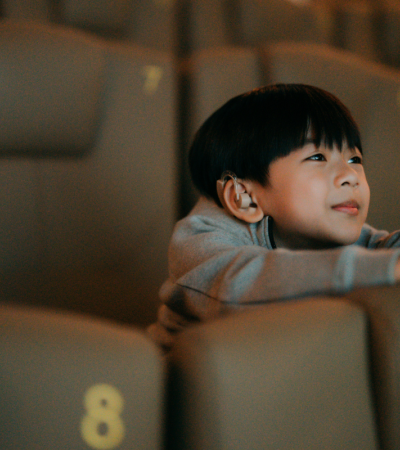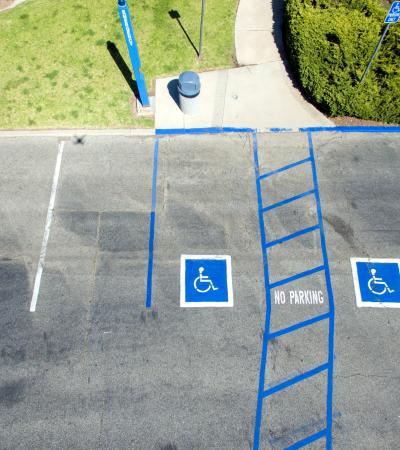What does it mean for a library to become a more accessible institution?

First and foremost, it means putting the disability rights movement’s ethic of “Nothing About Us Without Us” into practice. Enacting this adage means recognizing that any effort to increase library accessibility must be an effort made with, by, and for the people who will be affected by it. Put another way, it means foregrounding the unique perspectives and experiences of people with disabilities and recognizing that they are essential to the process of planning and making accessibility adjustments to library spaces, services, and programs.
Are libraries listening and learning from the lived experiences of people with disabilities? And if so, how has this impacted their accessibility work?
This past year, the American Library Association’s (ALA) Libraries Transforming Communities: Accessible Small and Rural Communities (LTC) initiative provided hundreds of libraries located in small and rural communities with grants to pursue projects to enhance accessibility and better serve the needs of patrons with disabilities. The evaluator of LTC, Knology, has been analyzing reports by LTC libraries in order to share what they are learning with the field and provide guidance for other libraries pursuing accessibility projects. Reading through libraries’ interim reports, we learned that many LTC libraries are putting the “Nothing about us without us” maxim to use. By involving patrons with disabilities directly in planning and implementation, a significant percentage of grantee libraries have made improvements to the accessibility projects they initially conceived.
What we found
Community input had a huge impact on LTC libraries’ accessibility plans. After holding community conversations with the audiences their accessibility projects aimed to serve, 76 out of 214 libraries decided to change these plans (either completely or partially). Among these 76 libraries:
- 25 decided to add to their original plans by addressing additional needs brought up by patrons
- 17 switched to a different project altogether
- 12 retained aspects of their original plans but replaced others
- 11 decided to focus on a subset of their originally planned projects
- 11 kept their original idea but changed some details based on community input
Here we focus on those 17 small and rural libraries that completely reworked their plans for accessibility projects. Drawing on libraries’ interim reports, we focus on three lessons these libraries learned through community conversations.
Communities prioritize physical access as a crucial first step
Of the 17 libraries that changed their plans completely, most did so because the conversations they held with their communities helped them to identify a high priority need that they had not previously thought of. For many community members, accessing the library’s physical space was a concern that outweighed other needs. Adhering to these needs often prompted libraries to shift from plans focused on collections development toward projects targeting points of physical entry – what one report described as “the first obstacle people with disabilities experience when they try to enter the library.”
Staff at Athens Public Library in Athens, MI, had originally planned to use their LTC funds to purchase additional collection materials for individuals with reading disabilities. Discussions with community members revealed that their primary audience was “not as interested in these items” as they were in updates that would make it easier to enter the building (which includes two sets of doors and a foyer area separating inside and outside). As nearly 70% of those who gave feedback indicated a need for easier physical access, community members and library workers jointly decided that they would redirect grant funding toward the purchase of automatic, accessible doors.
A similar process played out at the Delmont Public Library in Delmont, PA, where staff had initially planned to develop an accessibility resource guide for their neurodivergent patrons, as well as mindfulness resources and materials that aid in emotional regulation for individuals living with trauma. Discussion with the audiences that their project aims to serve made clear the fact that (as the library’s report put it) “some individuals have trouble getting through the door that keeps people out of the building to get resources or attend programs.” In response to these needs, the library plans to install automatic door openers. Staff will also continue to “partner with the individuals who participated in the conversation to ensure” that what they are doing is “truly beneficial” and helps “to continue making the Delmont Public Library a welcoming environment.”
Safety is a foremost concern for library patrons with disabilities
Along with prioritizing physical access, LTC libraries learned that making their buildings accessible to people with disabilities means ensuring that its spaces, services and programs do not pose a risk to patrons’ safety and wellbeing. Discussions on this topic prompted some libraries to make significant adjustments to their original projects.
At the Granville Public Library in Granville, MA, staff originally planned to use their LTC funds to construct a ramp at the building’s entrance. During a community conversation it became apparent that patrons with disabilities were less interested in this project (which would take months to complete) than in more immediate, short-term “gap measures” – for example, installing grab bars in the library bathroom, placing rubber safety treads on the stairs, and adding a second handrail to all staircases. As the library’s report noted, “patrons really consider safety a priority until we can become fully accessible.” Because they wanted the library to bring different kinds of people together through programming, community members valued changes to interior spaces that would make it safer and more accessible to all patrons.
Safety was also the primary concern for patrons with disabilities at the Stillwater Public Library in Stillwater, NY. There, library staff had planned to use their LTC grant to build a sidewalk that would connect the library to a nearby park. But when they hosted one-on-one conversations with individuals with disabilities who frequent the library, they heard that connecting the building to the park was much less important to patrons than ensuring that the library’s parking lot was properly paved and safe for individuals using wheelchairs, walkers, and canes. Since the library’s lot is currently unpaved, it presents a risk to individuals who may not feel as stable when they are using an assistive device. To prevent patrons from falling or injuring themselves while trying to cross the lot, library staff decided to pivot toward prioritizing patron safety. With a newly paved parking lot, the library hopes that it will draw more seniors and patrons with disabilities to its programs, and it plans to reach out to these groups as soon as the project is complete to assure them of the library’s safety and accessibility.
Through community conversations, staff at the Emery County Library System in Huntington, UT also decided to make upgrades with an eye to safety. The library's initial plan was architectural in nature: it had decided to build a ramp at the building's rear entrance. Patrons believed that improving its front entrance was a higher priority, as many expressed safety concerns related to hazards such as uneven concrete and the seasonal winter build up of ice along a path shaded by larger trees. After hearing these concerns, the library decided to trim the trees, repave the library's front entrance, and look for funds to purchase automatic door openers.
Inclusive programming often requires staff training
To become truly inclusive spaces, some libraries learned that they need to start by educating their staff on the meaning of accessibility and common barriers to access that people with disabilities often face.
For example, staff at the Belen Public Library in Belen, NM had planned to leverage their LTC funding to expand their home delivery services and conduct an accessibility audit of their space. When they presented these plans to community members, they learned that instead of developing new services and programs, some patrons with disabilities preferred that the library work to make existing ones even more inclusive – for example, by providing staff with training to help them learn about the resources and support people with disabilities need to fully participate in activities. Now the library is planning to dedicate a portion of its funds to accessibility training for all staff members and to rethink aspects of the programs it already runs to make them more inclusive for patrons with different kinds of disabilities.
Similarly, at the Peabody Public Library in Columbia City, IN, library workers learned from a series of community conversations that many patrons with disabilities prioritized inclusivity and accessibility enhancements to existing spaces, programs, and services over the development of new ones. They also suggested that, for this to happen, it would be helpful if staff were educated on the diverse needs of people who live with a disability. Training, for Peabody and other libraries, was seen as an important opportunity to make people with disabilities feel more welcome and safer at the library. The library has now decided to spend part of its grant funding to recruit a disability services and support organization to provide them with training on how they can best support their patrons with disabilities.
How libraries put “nothing about us without us” into practice
Small and rural libraries are making important strides toward becoming more inclusive institutions. They are doing this not only by leveraging LTC grant funding to pursue projects that aim to make their programs, services, and spaces more accessible for patrons who are disabled or neurodivergent, but also by ensuring that the perspectives of people with disabilities guide their progress. Incorporating diverse knowledge and perspectives into planning accessibility projects has, for many LTC libraries, resulted in necessary pivots. It has also resulted in library workers learning what really matters to people with disabilities within their communities as well as what libraries can do to better serve those needs. As the LTC initiative continues, the libraries featured here will keep making progress to realize their accessibility projects. As these libraries advance, we hope to learn more from them about the different opportunities and challenges that arise in their projects, and what they are learning along the way.
Recommendations
There is a wealth of resources out there for those looking to increase accessibility at their libraries. The “Serving Patrons with Disabilities in Small and Rural Libraries: Practitioner’s Guide” is one such resource. Here are a few recommendations we pulled from the “Practitioner’s Guide” (as well as from our own research) that suggest some concrete steps libraries can take to better serve patrons with disabilities:
- Look to increase the accessibility of your existing programs and services rather than feeling like you need to invent something new or start from scratch.
- Remember that programming spaces need to be accessible both physically and sensorially. Try making programs more sensory-friendly by offering the audience a basket of fidget toys or noise-canceling headphones.
- To learn about the accessibility needs in your community, consider partnering with a local organization. Local organizations may have knowledge about the community you are trying to serve that they would be willing to share with you!
- Communicate the accessibility changes you make to the audience(s) you are hoping you reach.
About this Article
This article is part of a series of blog posts exploring how libraries that received funds through ALA’s LTC: Accessible Small & Rural Communities are working to better meet the needs of patrons with disabilities. In other posts in this series, we look at attempts to put the disability rights movement’s ethic of “Nothing About Us Without Us” into practice and consider efforts focused on neurodivergent patrons and older adults. For more on how libraries can become more accessible to patrons with disabilities, see the collection of resources we assembled. And for more information about LTC, see our historical overview of this initiative.
Knology is a nonprofit research organization that produces practical social science for a better world. The organization pursues this goal to help professionals in a variety of sectors build inclusive, informed, and cooperative societies that can thrive together with the natural systems on which we all depend. As a transdisciplinary collective of over 30 social scientists, writers and educators, the organization's work process is built on equity, transparency and deliberation.



